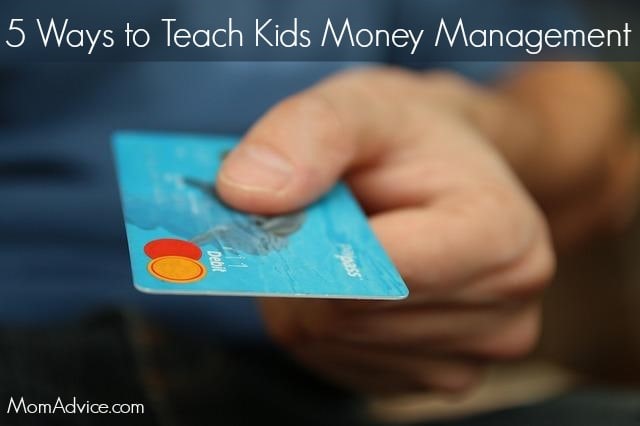From our money & finance contributor, Kelly Whalen.

Teaching kids to manage money can be a challenge, but with a little planning you can share lifelong skills that will help the kids in your life live a richer life.
5 Ways to Teach Kids Money Management
1. Give an Allowance
Allowances are useful tools that allow kids to manage their own money on a small scale. There are lots of considerations when giving your child an allowance.
- Should you give it to them weekly? Bi-weekly? Monthly?
- Will you track via an app or will you give the kids cash?
- Should you tie it to chores or simply use the allowance as a tool for learning?
What works for you and your children may take some time to sort out. Additionally it will depend on their age what you consider an appropriate amount of money and how often they should receive it. For instance, a 5 year old may only get $1 per week to spend and save, while a 14 year old may need $15 per week for things like school lunches, spending money, and savings.
Manage their expectations by being clear about the rules of how they spend their money. These are a few rules that we use with our kids that you may find helpful:
- No going into debt with the Bank of Mom & Dad
- Savings must equal 10% or more
- Giving must equal 10% or more
- Mom & Dad have final approval over all purchases
Start your kids on an allowance early (around age 5) and you’ll find plenty of teachable moments as they learn to manage their money.
Read more: Kids and Allowance
2. Make Giving a Priority
Giving back is an important part of our financial life so we pass on this value to our kids by making it clear that giving back is a priority. You can do this through monetary donations, but don’t overlook the value of time as well.
Ideas for Incorporating Giving Back as a Family:
- Set aside a % of allowance for donations
- Commit to donating X hours of time each month as a family
- Participate in community events like Fun Runs to raise funds and awareness for a cause
- Find small ways to give back such as buying extra school supplies for your children’s teachers or collecting gently used winter gear for kids in your community
- Give back by donating items you no longer need like giving used books to your local public or your school library
Read more: 5 Ways you Can Teach Your Kids to Give Back.
3. Encourage Mistakes Now
Encourage your kids to have some freedom to make mistakes with their money now so that they learn when they are young how those mistakes can impact their long-term goals.
For instance, if your child decides they “must have” a toy or item that you know won’t be worth the money you can explain it to them, but also allow them room to make their own decision. They will quickly learn how certain toys are marketed to seem much more fun than they really are!
While it’s hard to watch your child make mistakes they will learn from their actions instead words, and those lessons tend to stick with them much longer. It’s better to make a $10 mistake now than it is to make a $10,000 one when they are an adult.
4. Practice what you Preach
Speaking of actions being louder than words-be sure to show your kids a good example as well. While we’ve covered a range of financial topics here in the past it’s the everyday decisions our kids seem to latch onto readily.
By doing things like shopping with a list, avoiding impulse purchases, and sticking to your budget you will be doing more than just saving yourself money-you’ll be teaching your kids to do the same.
5. Involve Kids in Family Money Decisions
While some families may feel the family money is a private matter be sure to be open about how the bills are paid and how family money decisions are made. For instance, if you’re planning a family vacation you can set up a family money jar and discuss what things the family can cut back on to make the vacation a reality.
As kids get older you can become more open about your finances and teach them the real nuts and bolts of managing credit, debt, and making the tough financial decisions that most of us face.
While your 6 year old may not need to know how much you pay for electricity each month you can explain how much you save if he turns his light off before he leaves for school. The older your child becomes the more you should share with them. For instance perhaps with a 16 year old you may be more apt to discuss car payments, insurance, and maintenance as they learn to drive.
What advice do you have for teaching kids money management skills?
Pin It